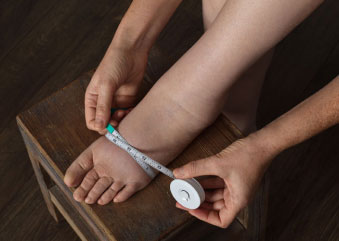
Lymphedema Treatment
in Traverse City & Cadillac, MI
What is Lymphedema?
Lymphedema is swelling that occurs in the arms or the legs due to a collection of too much lymph fluid. It typically affects the arms or legs, but can occur elsewhere. Discover lymphedema treatment near you at Northern Michigan Vein Specialists in Traverse City and Cadillac, MI, for effective care at our world-class vein clinic!


MEET Dr. Brian Heeringa, Board Certified
Brian Heeringa, M.D., is a Board-Certified General Surgeon, a Fellow of the American College of Surgeons and a Diplomate of the American Board of Venous and Lymphatic Medicine. He and his team treat a broad spectrum of venous conditions ranging from spider veins to varicose veins to venous ulcers and everything in between. We also offer DVT risk assessment and can help manage post thrombotic syndrome. Call today to find out how our team can help you with our lymphedema treatments!
Causes of Lymphedema
Primary Lymphedema
This form is much less common. It is a genetic problem where the person’s lymph nodes or vessels are missing or are poorly developed.
Secondary Lymphedema
This form is caused by another condition or disease that damages your lymph nodes or lymph vessels. Some of those causes include:
- Obesity
- Chronic venous insufficiency
- Cancer or radiation treatment for cancer
- Parasites
- Infection in the lymph nodes
- Surgery
- Lymph node removal
- Lymph node injury
What Are the Symptoms of Lymphedema?
- Swelling of part or all your leg or arm, including the digits/extremities.
- A feeling of heaviness or tightness
- Restricted range of motion
- Aching or discomfort
- Recurring infections
- Hardening and thickening of the skin (fibrosis)

What are the Stages of Lymphedema?
Lymphedema has four stages:
Stage 0

Also called latent lymphedema, there are no visible changes, but the lymph transport of fluid is impaired. Patients may have tightness in the skin or heaviness at this stage.
Stage 1

This is mild lymphedema. It includes mild swelling that will begin in the furthest part of the limb, such as the hand or foot, and slowly moves up the limb. Gravity causes this pooling during the day, and it may disappear at night when the limbs are raised.
Stage 2

Moderate lymphedema causes the skin to acquire a spongy appearance and it pits less than in Stage 1 because the skin is gradually thickening due to fibrosis. Fatty tissue will likely be accumulating below the skin due to inflammation from the lymph fluid building in the tissues.
Stage 3

Also known as severe lymphedema, the skin becomes very hard and scaly and enlarges significantly. The skin can begin leaking, a condition known as lymphorrhea as breaks in the skin cause lymph fluid to leak. Skin folds become a problem and infections can develop. The limbs become very heavy and impact movement.
Don’t let your Lymphedema Condition Progress!
Contact us today to evaluate your condition and discuss the best treatment options with our team of experts.
How Can Lymphedema Be Treated?
There is no cure for lymphedema, but it can be treated and kept in the lower stages. These are treatment approaches:
Compression garments
Fabric sleeves apply pressure onto the affected limb. This helps the lymph fluid to circulate, removing waste products.
Compression devices
These sleeves are attached to a pump that automatically applies and then releases pressure onto the limb on a timed schedule to prevent lymph fluid buildup.
Bandages
Wrapping the area can help push the lymph fluid toward the trunk of the body and out of the limb.
Massage
Lymphatic drainage massage helps to move fluid from areas of swelling to other areas where working lymph vessels can carry it away. Patients are also taught how to do this massage themselves for manageable at-home treatment wherever you are!
Exercise
Exercises may help promote lymph drainage and they will strengthen the affected limb.
